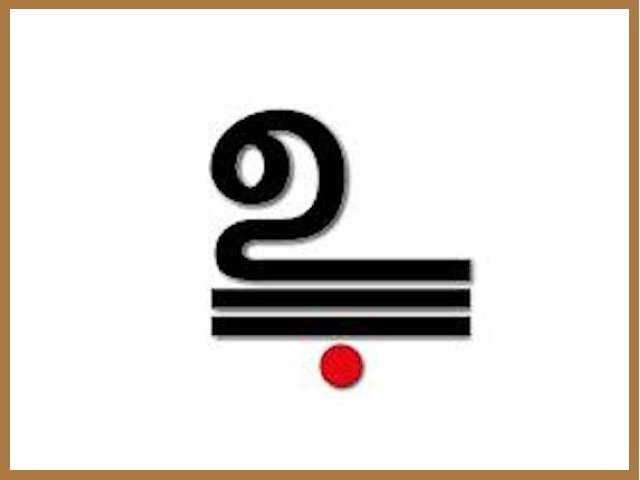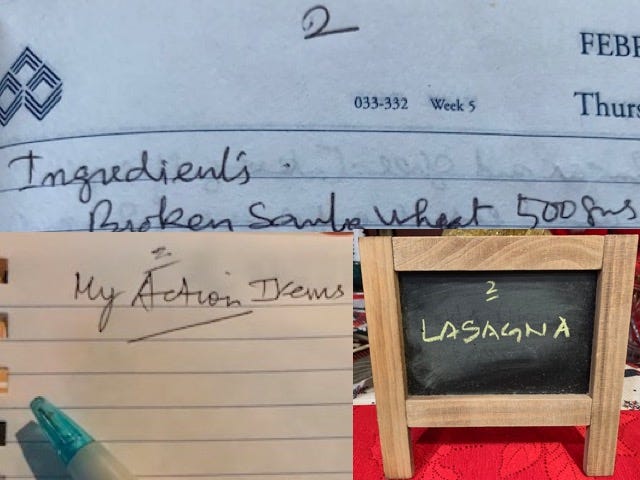Happy 2025!
Wishing You All The Best in the New Year.
In early 2024, my wife hosted a prep meeting for an upcoming event a few months later.
I was assigned the job of getting the place ready for the meeting.
So, in addition to cleaning the place, I got the dining table ready for the meeting with flip charts, note pad & pen for each attendee.
I titled the top sheet of each note pad “My Action Items” - so each person could simply jot down their ‘To-Dos’ from the meeting and take that sheet with them.
One of the attendees was a dear friend, who had worked with me in a prior life.
With a twinkle in her eye, she pointed to the top of each Action Item sheet where I had inscribed the Pillaiyar Suzhi (Lord Ganesha’s Curl).
She reminded me of the time when I used to start every meeting at work with a Pillaiyar Suzhi on the whiteboards.
This is true!
I have been an indiscriminate practitioner of the Pillaiyar Suzhi!
Pillaiyar Suzhi, as you know, is the symbol (Picture at the top) that is typically written at the top a new page to ask Pillaiyar’s (Lord Ganesha) blessings for an auspicious start, and to seek his help to remove obstacles along the way.
Runs in the Family
I really don’t remember when I started the practice of starting a new page with Pillaiyar Suzhi.
My father’s diaries, notebooks and letters would begin with a Pillaiyar Suzhi.
My mom was an avid Pillaiyar Suzhi user as well. In fact she used it for all her writings, including recipes to grocery lists!
I am guessing I was doing it because they did. Without really knowing why!
My friend from the top of this story says that her’s is a Pillaiyar Suzhi family. When she was being taught to write, her grandfather would first draw the Pillaiyar Suzhi on a clean slate before writing any letter. She continues the practice to this day, printing the Suzhi even on a check before filling it out!
I find it intriguing that some families are Suzhi users, while others are not. For example, in my wife’s family her dad doesn’t use the Pillaiyar Suzhi, while her mother does.
I guess Pillaiyar Suzhi is just like our other rituals and traditions. They vary from family to family depending on where they are from.
For us, it was a habit. A ritual.
Habitual.
The Backstory
As is the case in Indian mythologies, there are a few different stories of how the Pillaiyar Suzhi came to be.
One explanation of its origin is that it is a truncated version of the auspicious Tamil Om symbol below.
On the other hand, Pillaiyar Suzhi may have been the result of a practical need.
In ancient times, the sages and the learned would write using twigs and sticks on dried palm leaves. The Pillaiyar Suzhi has all the primitives of the letters in the Tamil alphabet - line, curve, dot, circle. So the Pillaiyar Suzhi was a quick test to determine the quality of the dried leaf for writing.
For me, however, the story that appeals the most, is the one by Kanchi Mahaperiyava.
According to him, the Pillaiyar Suzhi symbol is like the Tamil letter “oo”, which refers to Uma, a name for Parvati, Pillaiyar’s mother. The circle represents the universe and the curve that comes out of the circle shows that everything emanates from the universe. Mahaperiyava believed that the curve represents Pillaiyar’s trunk.
The straight lines are there to show that if anything goes astray, then one can straighten it by praying to Pillaiyar.
Do Other Cultures Have This?
Are Tamilians the only ones who have a symbol like Pillaiyar Suzhi? Do other cultures have anything equivalent?
In North India, the symbol “Shri” is used at the beginning of a document to denote “Shri Ganesh”.
“Shri Ganesh” means “to start with the blessings of Lord Ganesha”. It is actually a verb - “Humne Shri Ganesh kiya” (We started).
So, that is the same concept with a different symbol.
I poked around the Web to see if I could find similar ancient practices in other cultures.
I found prayers to use before you start writing a letter or book or some creative endeavor. There are a number of modern day personal rituals people follow in areas like in professional sports, creative artists and others.
There were Muses, who are Goddesses from ancient Greek religion and mythology and they serve as sources of inspiration in the Arts, Literature, and Science.
But none of these is encapsulated in an ancient symbol like Pillaiyar Suzhi that is still used today.
Why Do I Still Do It?
I have always been a big Pillaiyar fan, ever since I heard the story of Pillaiyar besting Murugan in a contest, on who can go around the world faster.
The story says that Pillaiyar simply circled his parents, Shiva and Parvati. He argued they were his world.
To me this is an example of how when you encounter an obstacle, you look for an innovative or creative way to remove it or work around it.
Better still, change the frame of reference or redefine the problem to your benefit.
Pillaiyar knew he couldn’t compete with Murugan and his peacock, flying round the world.
So he redefined the “world” to be his parents.
By starting with Pillaiyar Suzhi when creating something new, it encourages me to think differently to overcome challenges and achieve the goals.
Put it another way, that’s so Silicon Valley!
Your Thoughts!✍️
If you liked this piece, please “heart” it at the top of the article.
Do you use Pillaiyar Suzhi? How about your family? Tell me by clicking on the Leave a Comment button below.
Thank you for reading.
In case you missed it, here’s my previous Clear Mumble story:
Wish you all the Best in 2025!
Till Next Time,
Venkat









comparison of this practice across cultures is very interesting